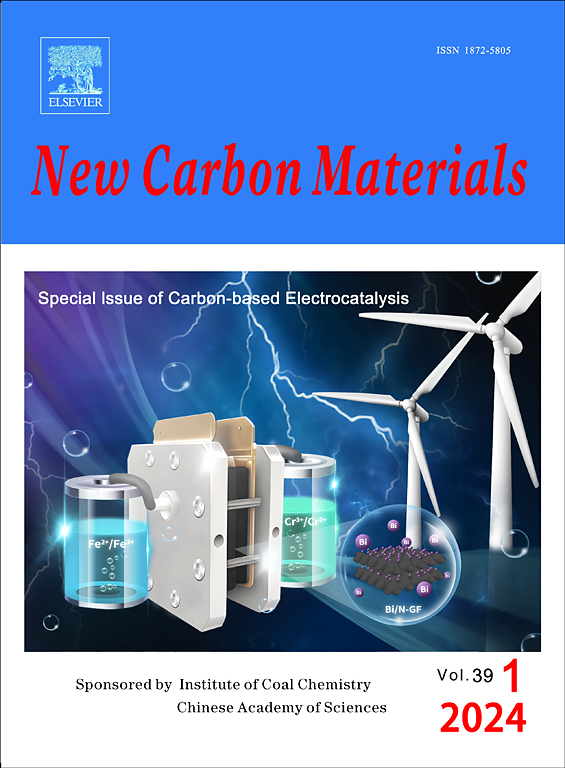The low-temperature deposition of a zincophilic carbon layer on the Zn foil for long-life zinc metal batteries
IF 5.7
3区 材料科学
Q2 Materials Science
引用次数: 0
Abstract
Aqueous zinc metal batteries (ZMBs) which are environmentally benign and cheap can be used for grid-scale energy storage, but have a short cycling life mainly due to the poor reversibility of zinc metal anodes in mild aqueous electrolytes. A zincophilic carbon (ZC) layer was deposited on a Zn metal foil at 450 °C by the up-stream pyrolysis of a hydrogen-bonded supramolecular substance framework, assembled from melamine (ME) and cyanuric acid (CA). The zincophilic groups (C=O and C=N) in the ZC layer guide uniform zinc plating/stripping and eliminate dendrites and side reactions. so that assembled symmetrical batteries (ZC@Zn//ZC@Zn) have a long-term service life of 2500 h at 1 mA cm−2 and 1 mAh cm−2, which is much longer than that of bare Zn anodes (180 h). In addition, ZC@Zn//V2O5 full batteries have a higher capacity of 174 mAh g−1 after 1200 cycles at 2 A g−1 than a Zn//V2O5 counterpart (100 mAh g−1). The strategy developed for the low-temperature deposition of the ZC layer is a new way to construct advanced zinc metal anodes for ZMBs.
- Download: Download high-res image (157KB)
- Download: Download full-size image
低温沉积在长寿命锌金属电池用锌箔上的亲锌碳层
水锌金属电池(zmb)是一种环保、廉价的电池,可用于电网规模的储能,但其循环寿命较短,主要原因是锌金属阳极在温和的水溶液中可逆性差。采用由三聚氰胺(ME)和三聚氰尿酸(CA)组成的氢键超分子骨架,在450℃的高温下,在锌金属箔上沉积了亲锌碳(ZC)层。ZC层中的亲锌基团(C=O和C=N)引导均匀的锌镀/剥离,消除枝晶和副反应。因此,组装的对称电池(ZC@Zn//ZC@Zn)在1ma cm - 2和1mah cm - 2下的长期使用寿命为2500 h,远远超过裸锌阳极(180 h)。此外,ZC@Zn//V2O5电池在2a g- 1下循环1200次后的容量为174 mAh g- 1,高于Zn//V2O5电池(100 mAh g- 1)。所开发的低温沉积ZC层的策略为zmb制备高级锌金属阳极提供了一条新途径。下载:下载高分辨率图片(157KB)下载:下载全尺寸图片
本文章由计算机程序翻译,如有差异,请以英文原文为准。
求助全文
约1分钟内获得全文
求助全文
来源期刊

New Carbon Materials
MATERIALS SCIENCE, MULTIDISCIPLINARY-
CiteScore
6.10
自引率
8.80%
发文量
3245
审稿时长
5.5 months
期刊介绍:
New Carbon Materials is a scholarly journal that publishes original research papers focusing on the physics, chemistry, and technology of organic substances that serve as precursors for creating carbonaceous solids with aromatic or tetrahedral bonding. The scope of materials covered by the journal extends from diamond and graphite to a variety of forms including chars, semicokes, mesophase substances, carbons, carbon fibers, carbynes, fullerenes, and carbon nanotubes. The journal's objective is to showcase the latest research findings and advancements in the areas of formation, structure, properties, behaviors, and technological applications of carbon materials. Additionally, the journal includes papers on the secondary production of new carbon and composite materials, such as carbon-carbon composites, derived from the aforementioned carbons. Research papers on organic substances will be considered for publication only if they have a direct relevance to the resulting carbon materials.
 求助内容:
求助内容: 应助结果提醒方式:
应助结果提醒方式:


